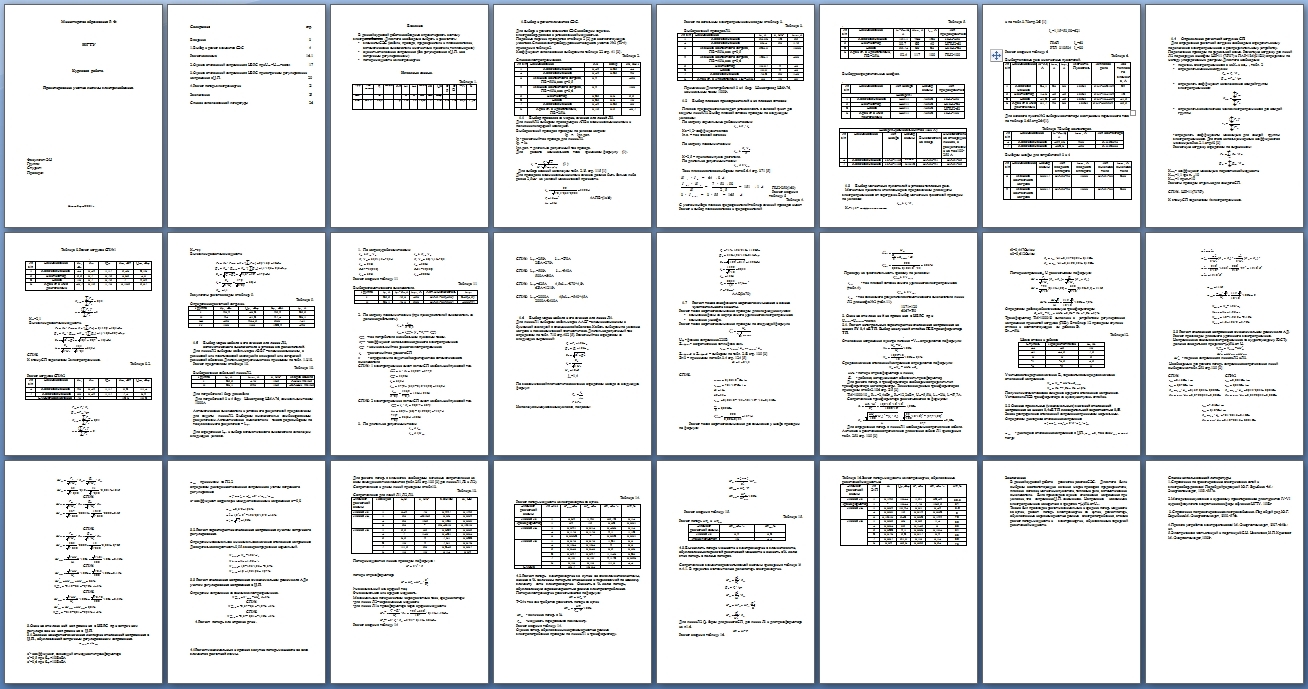Design of the power supply system
Sold 0
Refunds 0
Good feedbacks 0
Bad feedbacks 0
Introduction
Initial data
1. Selection and calculation of elements of SES.
1.1 Selection of wires of their brand, section for lines L3.
1.2 Selection of fuses and fuses
1.3 Selection of magnetic starters and thermal relay settings.
1.4 Determination of the estimated load JV.
1.5 Selection of cable brand and its section for line L2, circuit breaker and set point of its releases.
1.6 Selecting the brand of cable and its section for the line L1.
1.7 Calculation of single-phase short-circuit currents and the evaluation of the sensitivity of protection.
2. Assessment of voltage deviations in NVRS at Utsp = Uts.ps. = const.
2.2. Estimation of the limiting (maximum) values of voltage deviations on tires 0,4kV TP with confidence
probability of 0.95.
2.1 Calculation of the integral characteristics of the voltage deviation on the buses RU 0.4 kV TP. Choosing the best desoldering
PBV transformer TP.
2.3 Calculation of the voltage deviation in the maximum mode for blood pressure.
3. Assessment of voltage deviations in NVRS when counter voltage regulation in the TS.P.
3.1 Setting a specific value of the variance of the voltage deviations in the Ts.P., due to the counter
voltage regulation.
3.2 Calculation of the characteristics of voltage deviation, taking into account the counter regulation.
3.3 Calculation of the voltage deviation in the maximum mode for HELL taking into account the voltage regulation in the Ts.P.
4. Calculation of power losses.
4.1 Calculation of the maximum and average per day power loss in all elements of the design scheme.
4.2 Calculation of electricity losses per day in all elements of the system, an estimate in% of the magnitude of losses by
relation to the electricity transmitted for each network element. Estimate the percentage of losses in%
due to the uneven mode of power consumption.
4.3 Calculate the loss of power and electricity in the network elements due to the transfer of reactive
power and estimate in% the share of these losses in total losses.
Conclusion
References
Initial data
1. Selection and calculation of elements of SES.
1.1 Selection of wires of their brand, section for lines L3.
1.2 Selection of fuses and fuses
1.3 Selection of magnetic starters and thermal relay settings.
1.4 Determination of the estimated load JV.
1.5 Selection of cable brand and its section for line L2, circuit breaker and set point of its releases.
1.6 Selecting the brand of cable and its section for the line L1.
1.7 Calculation of single-phase short-circuit currents and the evaluation of the sensitivity of protection.
2. Assessment of voltage deviations in NVRS at Utsp = Uts.ps. = const.
2.2. Estimation of the limiting (maximum) values of voltage deviations on tires 0,4kV TP with confidence
probability of 0.95.
2.1 Calculation of the integral characteristics of the voltage deviation on the buses RU 0.4 kV TP. Choosing the best desoldering
PBV transformer TP.
2.3 Calculation of the voltage deviation in the maximum mode for blood pressure.
3. Assessment of voltage deviations in NVRS when counter voltage regulation in the TS.P.
3.1 Setting a specific value of the variance of the voltage deviations in the Ts.P., due to the counter
voltage regulation.
3.2 Calculation of the characteristics of voltage deviation, taking into account the counter regulation.
3.3 Calculation of the voltage deviation in the maximum mode for HELL taking into account the voltage regulation in the Ts.P.
4. Calculation of power losses.
4.1 Calculation of the maximum and average per day power loss in all elements of the design scheme.
4.2 Calculation of electricity losses per day in all elements of the system, an estimate in% of the magnitude of losses by
relation to the electricity transmitted for each network element. Estimate the percentage of losses in%
due to the uneven mode of power consumption.
4.3 Calculate the loss of power and electricity in the network elements due to the transfer of reactive
power and estimate in% the share of these losses in total losses.
Conclusion
References
TEXT EXAMPLES:
Introduction
In this course work necessary to design the power supply system. To do this, select and calculate:
- SES elements (cables, wires, fuses and fuses, circuit breakers and magnetic starters, thermal relays)
- estimate the voltage deviation (without regulation in the Ts.P. and with counter regulation)
- loss of power and electricity
1.1 Selection of wires of their brand, section for lines L3.
For lines L3 choose wire brand AR with aluminum conductors and PVC insulation.
The choice of wire sections is carried out according to the heating condition:
Ip
Introduction
In this course work necessary to design the power supply system. To do this, select and calculate:
- SES elements (cables, wires, fuses and fuses, circuit breakers and magnetic starters, thermal relays)
- estimate the voltage deviation (without regulation in the Ts.P. and with counter regulation)
- loss of power and electricity
1.1 Selection of wires of their brand, section for lines L3.
For lines L3 choose wire brand AR with aluminum conductors and PVC insulation.
The choice of wire sections is carried out according to the heating condition:
Ip
